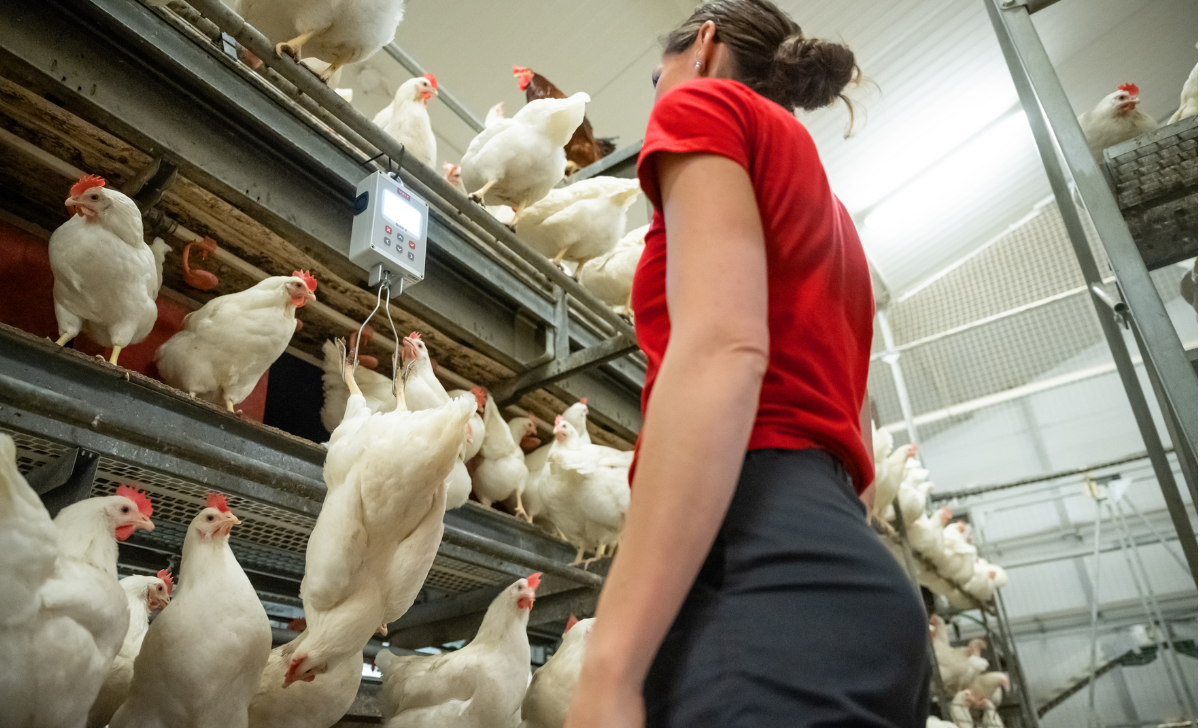Every poultry producer knows that chicken flock dynamics are complex. But what is chicken pecking order behavior exactly? The term comes from pioneering research by Norwegian zoologist Thorleif Schjelderup-Ebbe in 1921, who discovered that chickens establish a strict dominance hierarchy within their social groups (Strauss et al., 2022). Understanding this social structure is critical because when it breaks down, the consequences include increased aggression, feather pecking, injury, and reduced productivity that directly impact your bottom line.
Understanding Poultry Social Hierarchy
The chicken pecking order is a dominance hierarchy where each bird knows its exact rank in the flock. This chicken dominance hierarchy affects everything from access to food and water to nesting areas and perches (Hobby Farms, 2020). Larger, more dominant birds naturally rise to the top of this social structure, particularly apparent during feeding time (Cobb Breeder Management Guide, 2024).
Understanding poultry social hierarchy is essential because the pecking order serves important functions. It maintains social structure and reduces conflict when properly established, allowing flocks to function efficiently. However, when the hierarchy breaks down or becomes too aggressive, serious poultry behavioral problems pecking can emerge.
When Social Order Goes Wrong
Disruptions in the management of chicken flock pecking order can trigger welfare crises. Research shows that poultry behavioral management failures lead to feather pecking, aggression, and even cannibalism (Savory, 1995; Mels et al., 2023). These behavioral disorders often stem from overcrowding, nutritional deficiencies, or environmental stress.
Studies confirm that higher stocking densities and the occurrence of cannibalism and feather pecking significantly increase mortality rates (Kjaer & Vestergaard, 1999). In modern commercial operations housing thousands of birds, the natural social hierarchy cannot function as it would in smaller groups, contributing to increased welfare challenges.
Early Detection Through Weight Monitoring
The most reliable method for detecting welfare issues before they escalate is systematic weight monitoring. Research demonstrates that lower body weight and reduced flock uniformity are directly linked to social stress and welfare problems (Mels et al., 2023; Vasdal et al., 2019).
Managing chicken dominance issues starts with data. The BAT2 Connect automatic poultry scale provides continuous weight monitoring, calculating body weight uniformity by tracking animals that deviate from average weight. For smaller operations, the BAT1 manual poultry scale offers reliable measurements for flock health assessment.
Weight monitoring enables early intervention when problems arise. Studies show that monitoring body weight, uniformity, and mortality throughout rearing allows for counteractions that prevent welfare problems from spreading (Mels et al., 2023). Integration with BAT Cloud provides comprehensive data analysis for proactive management.
The hierarchy in chicken flocks is natural and necessary. But when welfare issues emerge that disrupt poultry social hierarchy, systematic weight monitoring becomes your first line of defense against costly problems like aggression, injury, and mortality.
References
Cobb Breeder Management Guide. (2024). Male Breeder Management. Cobb-Vantress. https://www.cobb-vantress.com/assets/Cobb-Files/management-guides/ca1b2a76ed/Cobb-Breeder-Management-Guide.pdf
Kjaer, J.B., & Vestergaard, K.S. (1999). Development of feather pecking in relation to light intensity. Applied Animal Behaviour Science, 62(2-3), 243-254. https://doi.org/10.1016/S0168-1591(98)00217-2
Mels, C., Niebuhr, K., Futschik, A., Rault, J.L., & Waiblinger, S. (2023). Body weight, uniformity and mortality of pullets in relation to different influencing factors. Preventive Veterinary Medicine, 217, 105929. https://doi.org/10.1016/j.prevetmed.2023.105929
Savory, C.J. (1995). Feather pecking and cannibalism. World’s Poultry Science Journal, 51(2), 215-219. https://doi.org/10.1079/WPS19950016
Strauss, E. D., Curley, J. P., Shizuka, D., & Hobson, E. A. (2022). The centennial of the pecking order: current state and future prospects for the study of dominance hierarchies. Philosophical transactions of the Royal Society of London. Series B, Biological sciences, 377(1845), 20200432. https://doi.org/10.1098/rstb.2020.0432
Vasdal, G., Granquist, E.G., Skjerve, E., de Jong, I.C., Berg, C., Michel, V., & Moe, R. (2019). Associations between carcass weight uniformity and production measures on farm and at slaughter in commercial broiler flocks. Poultry Science, 98(10), 4261-4268. https://doi.org/10.3382/ps/pez252
